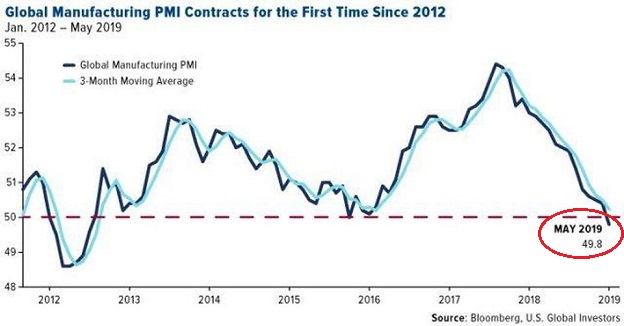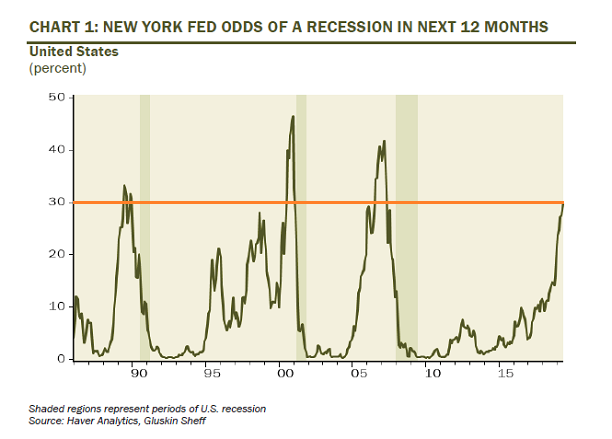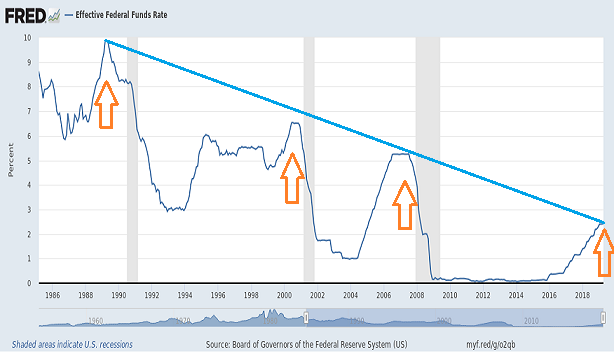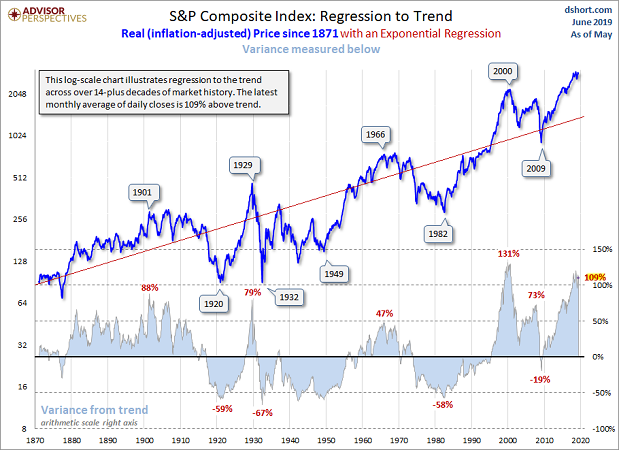Financial markets now anticipate that the Federal Reserve will begin ratcheting down rates from the 2.25%-2.50% range in July. Remarkably, the “de facto stimulus” associated with the Fed flip from rate raising to rate neutrality only lasted for six months.

Reasonable criticism of the Fed’s “way-too-low-for-way-too-long” rate policies notwithstanding, weak economic data may support easing. Imports (-2.7%) as well as exports (-4.2%) contracted. And global manufacturing is the weakest that it has been since 2012.

In a similar vein, corporate profits are downbeat. First quarter (Q1) earnings came in at -0.4%. Equally disconcerting, analysts are forecasting -2.1% for the second quarter (Q2).
In truth, earnings estimates may be too optimistic. Citi’s Economic Surprise Index has been, for the most part, decidedly negative.

Perhaps the biggest kicker? The jobs slowdown. According to the private payroll processing firm ADP), companies only created 27,000 new positions in May. That was the weakest reading since job losses bottomed out in March of 2010.
Even the Fed’s own recession model indicates trouble. The 30% probability marker preceded the three previous recessions. Will the fourth time be an unlucky charm?
Keep in mind, 30% likely matters in the recession prediction game. This is because the New York Fed’s model is a lagging indicator.

Perhaps ironically, stock investors are literally banking on a few strategic rate cuts to do the trick. Indeed, U.S. large cap stocks remain within spitting distance of an all-time peak.
Many may be misreading the tea leaves, however. When the Fed shifts from tightening to neutrality to easing, the Fed is often powerless to stop assets from repricing lower.
The shocking truth? The first few rate cuts after a tightening cycle heralded the last three recessions.

Could a couple of “insurance” rate cuts and an eventual trade deal with China be positive game changers? From my vantage point, these will not kindle an appetite for consequential risk taking.
Consider the peaks for the stock market in 2018 and in 2019. It has been nearly a year-and-a-half since a meaningful breakout for U.S. stocks. The Wilshire 5000 demonstrates just how little progress has been made since the high water mark in January 2018.

Far too many have become accustomed to the idea that bad news is good news. The weaker the economy, the more the stimulus. That may work when valuations are cheaper than dirt or when an expansion is in its early stages.
Unfortunately, U.S. stocks might need to revert to their mean before true bargains emerge. The idea that the stock market will avoid regressing to its trendline indefinitely is dangerous.

My defensive stance remains intact. Not only is our overall allocation to risk assets lower than it might otherwise be, but the nature of those risk assets interlocks with the tail end of a credit cycle.
For instance, we have a number of individual preferred stock shares with higher quality credit ratings. Others might choose the exchange-traded fund route with an index tracker like Van Eck Preferred ex Financials (NYSE:PFXF).
We also like dividend aristocrats and lower volatility yield producers. ETF enthusiasts might gravitate toward funds like Vanguard Dividend Appreciation (NYSE:VIG), ProShares S&P 500 Dividend Aristocrats (NYSE:NOBL) or Invesco S&P 500 High Dividend Low Volatility (NYSE:SPHD).
We also anticipate buying an eventual dip in U.S. Treasuries. Few assets hedge stock risk as well long-dated Treasury bonds.
In sum, there will be a great opening to become more assertive with stocks. It won’t be on a July rate cut. Or on a second one in September. Or on a third one in December.
The best time to take bigger risks with stocks will come when the Fed capitulates completely. When the Fed goes all in on zero percent rate policy (ZIRP), negative rate policy (NIRP) and its most massive quantitative easing program (QE) to date, the central bank’s unambiguous surrender is likely to usher in an incredible opportunity.
Disclosure: Gary Gordon, MS, CFP is the president of Pacific Park Financial, Inc., a Registered Investment Adviser with the SEC. Gary Gordon, Pacific Park Financial, Inc, and/or its clients June hold positions in the ETFs, mutual funds, and/or any investment asset mentioned above. The commentary does not constitute individualized investment advice. The opinions offered herein are not personalized recommendations to buy, sell or hold securities. At times, issuers of exchange-traded products compensate Pacific Park Financial, Inc. or its subsidiaries for advertising at the ETF Expert web site. ETF Expert content is created independently of any advertising relationships.
